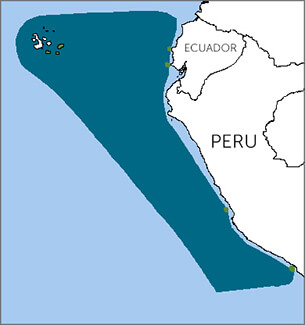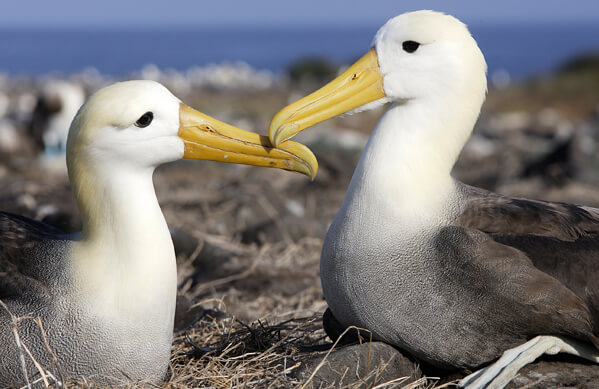
Waved Albatross map by NatureServe
While the Waved Albatross spends plenty of time riding air currents over the waves, its name actually derives from the wave-like pattern on this bird's brown body plumage. Like all members of the albatross family, including the Laysan and Black-footed Albatrosses, this superlative glider spends most of its life over the open ocean.
Also known as the Galápagos Albatross, the Waved Albatross has a seven- to eight-foot wingspan. Although it's the largest bird in the Galápagos, this species is just medium-sized for an albatross; the largest, the Wandering Albatross, has a wingspan of up to 12 feet!
A Change in Latitude
Birders who wish to add Waved Albatross to their life lists must travel south of the equator to Ecuador, the only place on Earth where this species breeds. Most Waved Albatrosses breed on Española Island in the Galápagos archipelago, but a smaller breeding colony can also be found on Isla de la Plata, 17 miles off the Ecuadorian coast.
Adult Waved Albatrosses winter at sea off the west coasts of Ecuador and Peru, where they may congregate in large groups. It is the only albatross species that lives its entire life within tropical latitudes.
Dashing Displays
Like other large birds, such as the Trumpeter Swan and Whooping Crane, Waved Albatross pairs mate for life. While they may winter apart, the birds meet again, year after year, on their familiar breeding grounds.
A fascinating mating ritual helps to strengthen pair bonds: Male and female face each other, large yellow bills touching, then stroke and tap their bills together, making a hollow sound. This "bill-circling" behavior is interspersed with bowing, bill-clattering, and sky-pointing, accompanied by a cacophony of hooting, honking, and whistling sounds.
Listen to the sounds of a Waved Albatross colony here:
(Audio: Scott Olmstead, XC24276. Accessible at www.xeno-canto.org/24276)
After mating, the female lays a single egg on bare, rocky ground, preferring areas where vegetation is trimmed short by grazing giant tortoises. On Española Island, where the native tortoises were almost wiped out by humans, vegetation grows more thickly and sometimes entangles Waved Albatross chicks. Ongoing conservation efforts are slowly returning the island to a healthier state, and more than 1,500 giant tortoises roam the island now.
Sharing the Load
The male and female share egg incubation duties over a two-month wait, then take turns foraging at sea to feed their chick. But at several weeks old, the young bird is mature enough to be left unguarded. Groups of chicks wait while parents fly to sea together and eventually return with stomachs full of food: a pre-digested, nutrient-rich oily liquid perfect for young albatrosses. This liquid can remain in the parent's stomach for a long period of time, enabling the adults to forage less frequently.

Waved Albatross coming in for a landing. Photo by Don Mammoser
Chicks start attempting to fly about five and a half months after hatching. In one of the most incredible aspects of albatrosses' lives, the fully fledged young birds will spend up to six years at sea before returning to land to find a partner. They will then return to breed each year of their long lives of up to 45 years.
Squid Snatching
Waved Albatrosses often feed at night when squid, their favored food, swim closer to the ocean's surface. The birds also eat fish, often scavenging near fishing boats, and a variety of marine invertebrates.
Like the Great Frigatebird, the Waved Albatross practices kleptoparasitism, stealing food from other birds such as Blue-footed Boobies. It's the only albatross known to regularly use this technique.
Save the Waved
Fisheries pose one of the biggest threats to the Waved Albatross and other seabirds such as the Pink-footed Shearwater. Longline fishing is a particular problem, attracting seabirds to hooked bait intended for fish. Each year, thousands of seabirds are accidentally caught on the hooks, pulled underwater, and drowned.
Climate change, which is warming the ocean currents that sustain seabird food sources in the waters off South America, also poses a major threat to the Waved Albatross. Scarce food sources make it even more likely that these birds may consume plastic floating on the ocean's surface, with disastrous results.
ABC's Seabirds Program works with partners to reduce these threats to the Waved Albatross and other seabirds through a combination of direct action, outreach, and policy work. Since 2008, ABC has worked in the artisanal longline fisheries of southwestern Ecuador to understand how Waved Albatrosses and other species interact with fishing gear — and how fishing practices can be modified to reduce accidental bycatch. ABC and collaborators at Humane Society International developed the NISURI Fastset system and standardized line weighting that enable fishers to set lines faster while virtually eliminating bycatch.
In Peru, we worked with the NGO ProDelphinus to eliminate the international capture of Waved Albatrosses for human consumption. We continue to urge the United States to support legislation to ratify the Agreement on the Conservation of Albatrosses and Petrels (ACAP). In addition, our interactive web-based tool, available free of charge, helps fisheries avoid accidentally catching seabirds.
Donate to support ABC's conservation mission!



















































